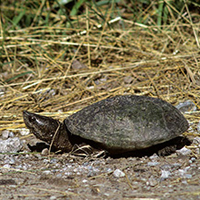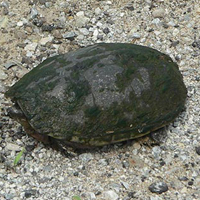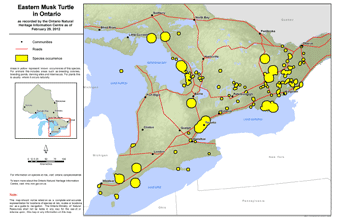Eastern musk turtle (stinkpot)
Scientific name: Sternotherus odoratus


Cover photo credit: Allen Woodliffe
Status
Special Concern
“Special Concern” means the species lives in the wild in Ontario, is not endangered or threatened, but may become threatened or endangered due to a combination of biological characteristics and identified threats.
Date added to the Species at Risk in Ontario List
The Eastern Musk Turtle was listed as threatened when the Endangered Species Act took effect in 2008, and was re-classified as special concern on June 27, 2014.
Read the report (PDF)
What it looks like
The Eastern Musk Turtle, also known as the Stinkpot, is a small freshwater turtle named for the musky, skunk-like odour it produces when disturbed. Its narrow, highly arched shell, less than 13 centimetres long, easily distinguishes this species from most other Ontario turtles that have wide, flatter shells.
The Eastern Musk Turtle has a dull black-brown body except for two distinctive yellow stripes often found on the side of the head.
Where it lives
Eastern Musk Turtles are found in ponds, lakes, marshes and rivers that are generally slow-moving have abundant emergent vegetation and muddy bottoms that they burrow into for winter hibernation.
Nesting habitat is variable, but it must be close to the water and exposed to direct sunlight. Nesting females dig shallow excavations in soil, decaying vegetation and rotting wood or lay eggs in muskrat lodges, on the open ground or in rock crevices.
Where it’s been found in Ontario
In Canada, the Eastern Musk Turtle is found mostly along the southern edge of the Canadian Shield in Ontario and Quebec.
In Ontario, it also occurs at various locations throughout southwestern and eastern Ontario.
The limited data available indicate that the stinkpot has disappeared from much of its original range in southwestern Ontario.
View a larger version of this map (PDF)
What threatens it
The most significant threat to the Eastern Musk Turtle is habitat destruction, primarily through wetland drainage, pollution and shoreline development.
This turtle is extremely vulnerable to drought and abnormally high water levels can drown eggs. Heavy motorboat traffic and intense angling increase adult mortality rates to potentially unsustainable levels.
Action we are taking
Special concern species do not receive species or habitat protection.
What you can do
Report a sighting
- Report a sighting of an endangered animal or plant to the Natural Heritage Information Centre. Photographs with specific locations or mapping coordinates are always helpful.
Volunteer
- Volunteer with your local nature club or provincial park to participate in surveys or stewardship work focused on species at risk.
Be a good steward
- Private land owners have a very important role to play in species recovery. If you find Eastern musk turtle on your land, you may be eligible for stewardship programs that support the protection and recovery of species at risk and their habitats.
- Never buy turtles that have been caught in the wild and never buy a native species of any kind that’s being sold as a pet.
- Eastern Musk Turtles can spend their entire life near the same water body, which provides important nesting and hibernation habitat. Maintain a buffer of natural shoreline vegetation and do not disturb aquatic vegetation. Old muskrat lodges, in particular, can be popular Eastern Musk Turtle nesting areas.
- Since Eastern Musk Turtles often bask in shallow water, they can be hard to see and can be easily hit by outboard motors of boats coming in to shore. If you know there are Eastern Musk Turtles in the area please drive carefully.
- Visit the Ontario Nature Ontario Reptile and Amphibian Atlas
www.ontarionature.org/atlas
or Toronto Zoo Adopt-a-Pond website
www.torontozoo.com/Adoptapond"
to learn more about Ontario’s rare turtles, their habitat, and related conservation initiatives.
Report illegal activity
- Report any illegal activity related to plants and wildlife to
1-877-TIP-SMNR (847-7667) .
Quick facts
- Unlike other turtles, the Eastern Musk Turtle rarely leaves the water except when females lay eggs. It spends most of the day resting on the soft lake bottom, foraging for food or basking in the sun under floating aquatic vegetation in shallow water.
- This turtle is a poor swimmer and usually walks along the lake bottom in search of food (aquatic molluscs and insects).
- The Eastern Musk Turtle is able to partially close the front portion of its shell for protection.
